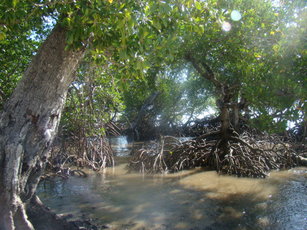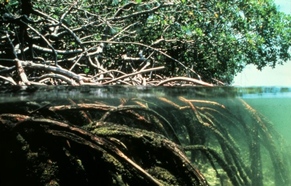Turning A New Leaf

- Introduction to Mangroves
- Global Distribution
- Shrimp Farming
- Management
- Restoration
- Conservation
- References
Introduction

Mangroves provide quite a few ecosystem services including habitat, refuge from predation, propagule enhancement sites, and food for organisms [1]. They also trap sediments, therefor protecting the coastline from erosion and they protect coral reefs and sea grasses from storms [2]. Mangroves also filter sediments and contribute organic matter to the surrounding estuaries [9]. Human uses consist of firewood, lumber, food, and medicine [1]. Mangroves are especially important in less-developed countries where those people depend on these forests for subsistence [9]. The trees have various adaptations that allow them to live submerged in highly saline waters. This includes:
- dense root system
- exclude or excrete salt
- tissues that allow for gas exchange in low oxygen soils
- reproductive adaptations: floating seeds
|
Video: Introduction to Mangroves and Their Importance
|
Video: Mangroves The Roots to the Sea
|
Mandi Cromar
The Oregon Institute of Marine Biology
Fall 2012
The Oregon Institute of Marine Biology
Fall 2012
